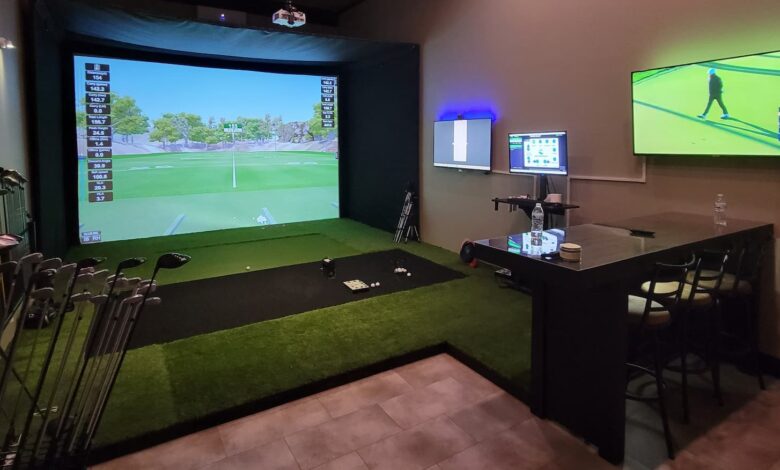Golf Simulator: The Future of Indoor Golfing

Introduction
Golf, the centuries-old sport known for its lush green courses, gentle breezes, and serene environments, has seen a technological revolution over the past few decades. Central to this evolution is the golf simulator, a system that allows players to experience golf without setting foot on an actual course. This informative article dives deep into the world of golf simulators, examining their advantages, technological advancements, and the future of indoor golfing.
The Basics: What is a Golf Simulator?
At its core, a golf simulator is a digital system that enables individuals to play golf on a graphically or photographically simulated driving range or golf course. It’s generally in an indoor setting. Using a blend of camera systems, infrared lasers, and advanced software, players can replicate the experience of playing on a real golf course. Every swing, putt, and drive is captured, analyzed, and displayed in real-time, giving immediate feedback to the player.
Why are Golf Simulators Gaining Popularity?
Convenience: With our increasingly busy lives, finding time for a full 18-hole round can be challenging. Golf simulators offer the flexibility to play anytime, irrespective of weather conditions.
Instant Feedback: Golf simulators are equipped with advanced sensors and software that analyze every aspect of a player’s swing, providing invaluable data for improvement.
Variety of Courses: Most advanced simulators come loaded with multiple courses from around the world. This means players can experience international practices without leaving their city.
The Technological Evolution of the Golf Simulator
The early versions of golf simulator were rudimentary, often offering cartoonish graphics and basic gameplay. However, with advancements in technology, modern simulators are near photorealistic. The latest simulators use:
High-Speed Cameras: These cameras capture every nuance of a player’s swing, from the angle of the club upon impact to the spin of the ball.
Advanced Software Algorithms: This software interprets the vast amount of data in real time to give an accurate projection of the ball’s flight.
Touchscreen Controls and VR Integration: Some of the latest simulators now offer touchscreen controls and are even venturing into virtual reality for a more immersive experience.
Training and Professional Use
Many professional golfers and coaches are turning to golf simulators for training purposes. The immediate feedback and data analytics can identify minor flaws in technique that might be missed on the actual course. Additionally, the ability to simulate various challenging conditions helps professionals prepare for tournaments more effectively.
The Social Aspects of Indoor Golfing
Golf simulators are not just for serious players. Many businesses, including pubs and entertainment centres, have incorporated golf simulators as a form of social entertainment. Friends can compete in tournaments, families can enjoy a fun outing, and businesses can even host team-building events, all in the comfort of an indoor setting.
The Future: Where is Indoor Golfing Heading?
As technology continues to evolve, the golf simulator experience will only get more advanced. We can expect:
More Realistic Graphics: As computer graphics technology improves, simulators will offer even more lifelike experiences.
Integration with Wearables: In the future, wearables might provide real-time data on player vitals, adding another dimension to the game.
Augmented Reality and More VR Integration: Augmented reality could blend the best of real-world and simulated golf, while increased VR integration could make indoor golfing even more immersive.
Cost-Benefit Analysis of Investing in a Golf Simulator
For many, the initial cost of a golf simulator might seem steep. But when you break down the expenses of regular golf outings – green fees, travel costs, equipment wear and tear, and sometimes even membership dues – the simulator starts to seem like a financially sound investment. Over time, especially for those who play frequently, a one-time investment in a golf simulator can outweigh the ongoing costs of traditional golfing. Moreover, businesses can capitalize on this trend by offering pay-per-play sessions, which can turn the simulator into a profitable venture.
Customization and Personalization: Making the Simulator Yours
Modern golf simulators are no longer a one-size-fits-all piece of technology. They come with numerous customization options. Players can adjust difficulty levels, set weather conditions, and even simulate different times of the day. On the software side, many simulators allow users to track their progress, set goals, and get personalized feedback based on their performance. This tailored approach not only enhances the playing experience but also aids in the faster improvement of the player’s game.
Integration with Fitness and Well-being
Golfing is not just a sport; it’s also an excellent way to maintain physical and mental well-being. Golf simulators, with their indoor convenience, can be integrated into a regular fitness regimen. Players can get a good workout while playing, focusing on core strength, flexibility, and mental concentration. Future simulators may even sync with fitness apps or devices, tracking calories burned, monitoring heart rate, or even suggesting warm-up and cool-down exercises.
Environmental Benefits: Going Green with Virtual Greens
The environmental impact of golf courses is a growing concern. They often require vast amounts of water, pesticides, and fertilizers to maintain their pristine conditions. Golf simulators present an eco-friendly alternative. By choosing to play virtually, players can enjoy the sport they love while reducing their environmental footprint. This is not to say that traditional golf courses will or should become obsolete, but golf simulators offer a sustainable alternative for the eco-conscious golfer.
Challenges and Criticisms: Is it Really Like the Real Thing?
Despite the myriad benefits, golf simulators have their critics. Purists argue that the virtual experience can never replicate the nuances and unpredictabilities of a real course. There are elements like the feel of the grass, the scent of the outdoors, and the subtle topographical changes that a simulator might not capture entirely. Furthermore, while technology can provide vast data, it might overwhelm or misguide amateurs without proper guidance. Balancing the simulator experience with real-world play and coaching can ensure a comprehensive golfing journey.
Conclusion
The golf simulator has transformed from a novelty to a vital tool for enthusiasts and professionals alike. It brings the essence of the golf course indoors, making the sport more accessible to everyone, regardless of time, weather, or location constraints. As technology marches on, we can only imagine how the line between the real and virtual golfing experience will blur, offering an even more enriching and engaging indoor golfing adventure.
Also, Read The Following: hac aldine



